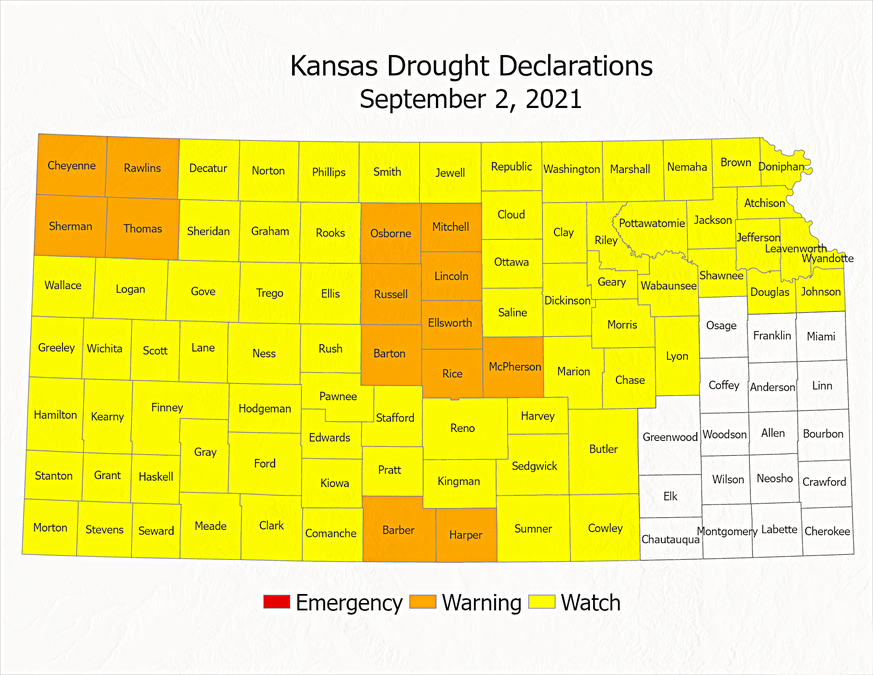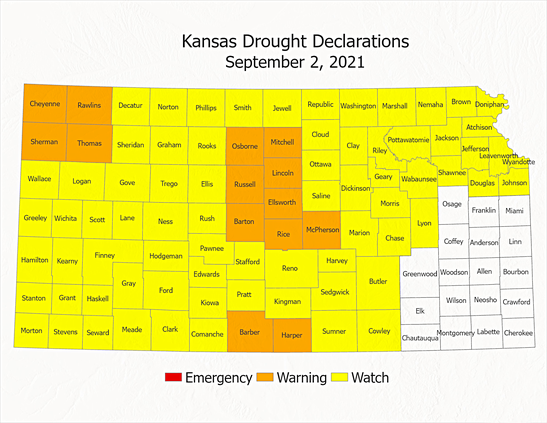Despite recent showers, of the 105 Kansas counties, 87 are either in a drought warning or drought watch status, including Barton. In response to this, Gov. Laura Kelly Thursday approved an executive order updating the drought declarations for the counties impacted by the lingering dry conditions.
The declaration placed 14 counties, Barton among them, into a warning status and 73 into a watch status. There are several Golden Belt counties in each of these categories.
“Unfortunately, the majority of the state of Kansas has been considered in a drought or abnormally dry conditions for the past several weeks,” Kelly said. “While we are very fortunate to be in a better situation than many states north and west of us, it doesn’t minimize our dry conditions. I encourage Kansans to be mindful of drought conditions, and work to minimize the threat of fires across the state.”
This action was recommended by Connie Owen, director of the Kansas Water Office and chair of the Governor’s Drought Response Team.
Kansas has experienced a wide range of precipitation this year with some areas receiving normal or more rainfall while others, such as northwest, central and south-central counties have received less than 60, 70 or 80 percent of the area’s normal, she said.
Situation being watched
“This year we have been in a better situation regarding drought than we were last summer. However, it doesn’t diminish the conditions being experienced throughout most of Kansas now,” Owen said. “The governor’s Drought Response Team will continue to monitor the situation and make recommendations to the governor as necessary.”
Future outlooks call for drought-like conditions to persist into the fall, especially for the northwestern counties, she said.
This order shall remain in effect for those counties so identified until rescinded by executive order or superseded by a subsequent executive order revising the drought stage status of the affected counties.
What does this mean?
According to KWO Communications Director Katie Patterson-Ingels, the declaration allows for the sharing of resources, the relaxing of some statutory restrictions and the activation of the National Guard. It also paves the way for sharing of information with local, state and federal agencies, as well as the general population. Effective immediately:
• Declaration of a Drought Emergency, Warning or Drought Watch for the counties identified is implemented.
• All agencies under the jurisdiction of the governor are directed to implement the appropriate response actions assigned in the drought team’s Operations Plan.
The Governor’s Drought Response Team will continue to watch the situation closely and work to minimize the effects the drought has on Kansans.
Drought watch counties include: Atchison, Brown, Butler, Chase, Clark, Clay, Cloud, Comanche, Cowley, Decatur, Dickinson, Doniphan, Douglas, Edwards, Ellis, Finney, Ford, Geary, Gove, Graham, Grant, Gray, Greeley, Hamilton, Harvey, Haskell, Hodgeman, Jackson, Jefferson, Jewell, Johnson, Kearny, Kingman, Kiowa, Lane, Leavenworth, Logan, Lyon, Marion, Marshall, Meade, Morris, Morton, Nemaha, Ness, Norton, Ottawa, Pawnee, Phillips, Pottawatomie, Pratt, Reno, Republic, Riley, Rooks, Rush, Saline, Scott, Sedgwick, Seward, Shawnee, Sheridan, Smith, Stafford, Stanton, Stevens, Sumner, Trego, Wabaunsee, Wallace, Washington, Wichita and Wyandotte.
In addition to Barton, drought warning counties include: Barber, Cheyenne, Ellsworth, Harper, Lincoln, McPherson, Mitchell, Osborne, Rawlins, Rice, Russell, Sherman and Thomas.
How is this done?
The KWO is responsible for monitoring drought and notifying the governor on drought conditions. This monitoring relies on data compiled by several state and federal agencies including the Kansas Department of Agriculture, the Kansas State University Weather Data Library and the Applied Remote Sensing Program at the University of Kansas.
To gauge conditions, they tap precipitation, stream flow, reservoir levels, and soil, crop and vegetation conditions. They also consider the U.S. Drought Monitor and the Seasonal Drought Outlook prepared by the National Weather Service.
Around since the 1980s, the drought team is led by the KWO director and made up of representatives from 11 state and federal agencies. Its job is to advise the governor.
For more detailed information about current conditions, see the Kansas Climate Summary and Drought Report on the Kansas Water Office website at: www.kwo.ks.gov.








